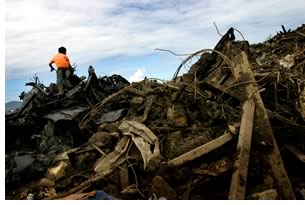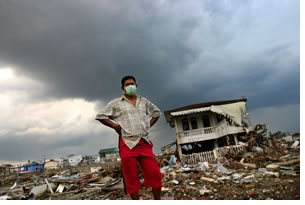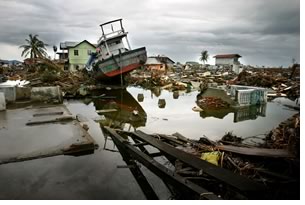

04/2005
Tsunami response coordinated
The AIA Disaster Assistance program is leading a collaboration of architects, engineers, and community planners who will lend their expertise and assistance to Sri Lanka’s tsunami relief efforts.
AIA members are making the trip to Southeast Asia the first week of May to examine what will be an appropriate role for the disaster assistance team. Making the trip are three AIA architects, three engineers from the American Society of Civil Engineers, and two representatives from the American Planning Association. Members of the American Society of Landscape Architects and the International Code Council are also expected to participate. The AIA’s Disaster Assistance program is part of the AIA Center for Communities by Design.
The tsunami put the AIA Disaster Assistance program in a heightened mode of awareness, so the call for volunteers went out in late February. “With the tsunami, the AIA national component is trying to serve as a leading collaborator,” says David Downey, Assoc. AIA, managing director for the AIA Center for Communities by Design and Disaster Assistance program. “The AIA is also seeing how the U.S. design and construction industry as a whole can lend its expertise and assistance to Sri Lanka.”
Volunteering here and abroad
The AIA has had disaster relief experience overseas, after the earthquake
in Kobe, Japan, and the earthquake in Armenia. Terrance Brown, FAIA,
senior architect of ASCG Incorporated in Albuquerque, NM, chair of
AIA’s Disaster Assistance program, and recipient of the AIA’s
2004 Whitney M. Young Jr. Award for service to the Institute, emphasizes
that performing disaster relief in another culture differs from that
of the U.S. “You’re dealing with people who are very poor.
You want to work with the native organizations that have already been
established working over the years in the development of these countries.
These people know their neighborhoods and their communities very well
and you want to work with those people and get them trained and let
them be the leaders of bringing in supplies.”
In a domestic disaster, it is the AIA state component that needs an emergency response plan, according to Charles Harper, FAIA, former chair of the AIA Disaster program, principal of Harper Perkins Architects in Wichita Falls, Tex., and 2001 recipient of the AIA’s Edward C. Kemper Award. “Disaster relief at the state level is the most effective approach because government agencies—like the Federal Emergency Management Agency—coordinate disaster-response efforts with the state’s governor, the town’s mayor, and with the state agencies, which usually include home builders, construction contractors, the insurance agencies, and the building code representatives. The AIA state component must know how state relief works. It’s different from an overseas operation, where the cultures can be laissez faire.”
The AIA has built a database of 70 volunteers. Downey states that most of the volunteering is damage assessment and has to be done in the field. Volunteers can register at the AIA Web site, where they should give information about their expertise. “We do provide opportunities for people to define the scope of their interest,” says Downey, “whether it’s local, state, domestic or international efforts.”
 What architects need to know
What architects need to know
Harper explains that there are three stages of disaster relief efforts:
emergency, relief, and recovery. “The first response at a disaster
is caring for the injured and getting people emergency shelter and
food,” says Harper. “Next, short-term housing and medical
services are needed. Then, the damage needs to be assessed, such as
examining building conditions. The AIA’s Disaster Assistance
Program provides volunteers with a worksheet for assessing exterior
and interior damage and the condition of the construction and the roofing.” For
domestic relief disaster, copies should be made for the home owner,
insurance company, FEMA, and state agencies.
Once an AIA team arrives at a relief site, architects need to set up a local office, says Harper, and establish a leader. “The base of operations needs to be well supplied with maps, assessment worksheets, office equipment, and telephone service. Know the media contacts and select a media spokesperson.” He points out that AIA architects need to get information regarding the severity of damage, the locations, and the areas impacted, such as commercial or residential. It is also important to know telephone status and roadway conditions leading into disaster zones.
Need for quality control
After assessment, a community needs a long-term plan of urban and neighborhood
redesign. “This may include relocating utilities or changing
building codes, such as requiring the reinforcement of deep overhangs
on a house,” Harper says.
Harper stresses the need for quality control. “A community struck by a disaster has to be cautioned not to have demolition fever and rebuilding fever. Sometimes the first reaction is to tear everything down, which is wrong. Some buildings can be fixed, or preserved, as in the case of historic sites. There also might be a chance to improve a building, rather than replace it. A long-term goal is not to put it back like it was, but to put it back better than it was.”
Brown also cautions against quick rebuilding. “You don’t want to rush into building things that are not within the building codes. Everybody wants to rebuild and rebuild fast, but don’t be tempted to build things in a shoddy manner to give rapid shelter.” And quick demolition is not recommended. “For example, you don’t want to bulldoze right after an earthquake,” says Brown. “People have lots of valuables. Plus, there is also building material there that people can re-use.”
Floods most common
According to FEMA’s Web site, floods are the most common and widespread
of all natural disasters, except fire. “All disasters are about
the same in terms of relief efforts,” mentions Harper, “but
floods are about the most difficult to organize because floods can develop
over a period of days.”
Brown explains that there are AIA flood procedures that explain what architects need to look for in floodwater damage. “Carpets, wood floors, walls, the electrical and gas systems,” he says. “Watch for gas leaks because they can start fires. And mold and mildew can also cause a tremendous amount of damage.”
Harper recommends that an evaluation visit should be about 30-45 minutes, depending on the disaster and expertise of the team. “Recommend changes to the mayor and city council. At the end of the visit, the AIA team should deliver a written report to the state disaster recovery board.”
 Phase II is key
Phase II is key
Downey says it is the second phase of disaster assistance—relief—when
architects should get involved. “The emergency level is not an
area where the AIA or architects find themselves to be of the most value,” Downey
says. “That is where you will find the Red Cross and FEMA; they
are the first responders. We respond immediately on the heels of those
organizations in the relief phase as it relates to assessment. Architects
evaluate whether a building can be inhabited again or if it needs to
be red-tagged as ‘do not enter.’”
Architects make recommendations for short-term rebuilding in this phase, Downey says. “If it appears that you have a roof that is sagging, it can be analyzed by the architect and evaluated for its overall stability. If there is concern for puncture in the outer skin, an architect can quickly recommend how to cover it and make it wind and water resistant.”
In the long-term recovery phase, architects play a very important role in very fast-paced construction document preparation. “In the areas hit by the recent tsunami, entire infrastructures were gone: medical facilities, schools, municipal buildings,” says Downey. “So not only are there housing concerns, there are businesses and life-saving infrastructures that need to be put back in place. The role of the architect is to make sure that gets done, and in a timely fashion.”
Downey stresses that large-scale rebuilding discussions need to occur earlier than later. “The immediate tendency is to rebuild it exactly where it was. For instance, in coastal conditions, it may be that a school or hotel was too close to the coast. So there needs to be an evaluation of whether that was the appropriate place for such a structure. Maybe rebuilding could mean changes in the land-use, altering the orientation of a structure, or making things more compact. Such decisions are going to be discussed and made. Architects can make certain these talks and decisions are made early-on in the relief stage, not in the recovery stage.”
When architects volunteer their time and expertise, they may be protected
by a Good Samaritan law, which, explains Downey, protects architects
from litigation or otherwise reduce their potential liability in making
initial assessments. “A post-disaster response condition is not
an extensive field study.” Harper adds not to give cost estimates
to home owners when making assessments.
The importance of volunteering
AIA architects make sacrifices when they volunteer for disaster assistance
but feel it’s a worthwhile effort, explains Downey. “These
are people who pack and go and have the capacity to take leave from
work, without pay, to do volunteer work for 1-2 weeks out in the field.
They are doing it for their concern for the health, safety, and welfare
of communities and people. We just ask that they qualify what they
are willing to commit to should they be needed, and outline their experience
and education for us.”
Harper notes, “The impact of volunteers is invaluable. They make a big difference.” Downey agrees: “There is speculation that the chaotic nature of the weather might continue, so I can see where volunteers are going to become more critical.”
Brown believes that the AIA is very prepared to handle disaster relief. “The Disaster Assistance Program is one of the strong points that the AIA has to offer. In the end, we want to have architects prepared for the next disaster, and there will be one. But we can offer to train architects and have them ready to go. We can go out and make a difference when it is needed.”
Copyright 2005 The American Institute of Architects.
All rights reserved. Home Page ![]()
![]()
 |
||
Call
for Volunteers: AIA members interested in being considered
to assist in disaster-assistance efforts in the U.S. and abroad
can register with the AIA
Disaster Assistance Program online. Training Workshop at Convention: At the 2005 AIA National Convention
in Las Vegas, Wednedsay, May 18, 1-5 p.m., Terrance J. Brown, FAIA,
ASCG Incorporated; Thaddeus L. Cohen, AIA, Florida Department of
Community Affairs; and Charles F. Harper, FAIA, Harper Perkins
Architects, will present the “Training Architects to Help
Communities Recover from Disasters” workshop. Visit the AIA
Convention Web site for details. The Center for Communities by Design maintains a library of publications on disaster mitigation, damage assessment, and post-disaster recovery. For more information, send e-mail. The AIA eClassroom provides a distance-education program on disaster training. In the weeks after the December 26, 2004, earthquake and tsunami, coastlands of the Indian Ocean faced a disaster emergency. As the situation continues to develop into disaster relief and recovery, architects’ knowledge of damage assessment, community planning, and building design becomes increasingly valuable. Photos of Banda Aceh, Indonesia, January 2005, copyright J Carrier/www.j-carrier.com
|
||
